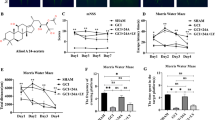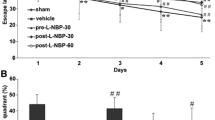Abstract
Nicotinamide adenine dinucleotide (NAD) is a critical cosubstrate for enzymes involved in supplying energy to the brain. Nicotinamide riboside (NR), an NAD+ precursor, emerges as a neuroprotective factor after chronic brain insults. However, researchers have not determined whether it improves cognition after acute ischemia. In the present study, mice with middle cerebral artery occlusion were treated with NR chloride (NRC, 300 mg/kg, IP., 20 min after reperfusion). The results of the Morris water maze test revealed better recovery of learning and memory function in the NRC-treated group. Acute NRC treatment decreased hippocampal infarct volume, reduced neuronal loss and apoptosis in the hippocampus. Western blot and high-performance liquid chromatography assays of hippocampal tissues revealed that the activation of Sirtin-1 and adenosine 5′ monophosphate-activated protein kinase was increased, the NAD content was elevated, and the production of adenosine triphosphate was strengthened by NRC. Collectively, acute NRC treatment increased the energy supply, reduced the neuronal loss and apoptosis, protected the hippocampus and ultimately promoted the recovery of cognitive function after brain ischemia.








Similar content being viewed by others
Data Availability
The datasets generated and/or analyzed during the current study are available from the corresponding author upon reasonable request.
Code Availability
Not applicable.
Abbreviations
- NAD:
-
Nicotinamide adenine dinucleotide
- NR:
-
Nicotinamide riboside
- NRC:
-
Nicotinamide riboside chloride
- HPLC:
-
High-performance liquid chromatography
- Sirt1:
-
Sirtin-1
- AMPK:
-
Adenosine 5′ monophosphate-activated protein kinase
- ATP:
-
Adenosine triphosphate
- MCAO:
-
Middle cerebral artery occlusion
- PARP1:
-
(ADP ribose) polymerase 1
- PGC1α:
-
Proliferator-activated receptor-γ coactivator 1α
- AI:
-
Apoptosis index
- BDNF:
-
Brain-derived neurotrophic factor
- iPSC:
-
Induced pluripotent stem cells
- LKB1:
-
Liver kinase B1
References
Katan M, Luft A (2018) Global burden of stroke. Semin Neurol. https://doi.org/10.1055/s-0038-1649503
Kathner-Schaffert C, Karapetow L, Günther M et al (2019) Early stroke induces long-term impairment of adult neurogenesis accompanied by hippocampal-mediated cognitive decline. Cells. https://doi.org/10.3390/cells8121654
Guo X, Qun Xue Q, Zhao J et al (2020) Clinical diagnostic and therapeutic guidelines of stroke neurorestoration (2020 China version). J Neurorestorat. https://doi.org/10.26599/JNR.2020.9040026
Braidy N, Grant R, Sachdev PS (2018) Nicotinamide adenine dinucleotide and its related precursors for the treatment of Alzheimer’s disease. Curr Opin Psychiatry
Hosseini L, Mahmoudi J, Pashazadeh F, et al (2021) Protective effects of nicotinamide adenine dinucleotide and related precursors in alzheimer’s disease: a systematic review of preclinical studies. J Mol Neurosci
Hosseini L, Vafaee MS, Mahmoudi J, Badalzadeh R (2019) Nicotinamide adenine dinucleotide emerges as a therapeutic target in aging and ischemic conditions. Biogerontology
Covarrubias AJ, Perrone R, Grozio A, Verdin E (2021) NAD+ metabolism and its roles in cellular processes during ageing. Nat Rev Mol Cell Biol
Xie X, Gao Y, Zeng M et al (2019) Nicotinamide ribose ameliorates cognitive impairment of aged and Alzheimer’s disease model mice. Metab Brain Dis. https://doi.org/10.1007/s11011-018-0346-8
Braidy N, Liu Y (2020) Can nicotinamide riboside protect against cognitive impairment? Curr Opin Clin Nutr Metab Care. https://doi.org/10.1097/MCO.0000000000000691
Vaur P, Brugg B, Mericskay M et al (2017) Nicotinamide riboside, a form of Vitamin B3, protects against excitotoxicity-induced axonal degeneration. FASEB J. https://doi.org/10.1096/fj.201700221RR
Gong B, Pan Y, Vempati P et al (2013) Nicotinamide riboside restores cognition through an upregulation of proliferator-activated receptor-γ coactivator 1α regulated β-secretase 1 degradation and mitochondrial gene expression in Alzheimer’s mouse models. Neurobiol Aging 34:1581–1588. https://doi.org/10.1016/j.neurobiolaging.2012.12.005
Lee HJ, Yang SJ (2019) Supplementation with nicotinamide riboside reduces brain inflammation and improves cognitive function in diabetic mice. Int J Mol Sci. https://doi.org/10.3390/ijms20174196
Cantó C, Gerhart-Hines Z, Feige JN et al (2009) AMPK regulates energy expenditure by modulating NAD+ metabolism and SIRT1 activity. Nature 458(7241):1056–1060. https://doi.org/10.1038/nature07813
Longa EZ, Weinstein PR, Carlson S, Cummins R (1989) Reversible middle cerebral artery occlusion without craniectomy in rats. Stroke 20:84–91. https://doi.org/10.1161/01.STR.20.1.84
Morris R (1984) Developments of a water-maze procedure for studying spatial learning in the rat. J Neurosci Methods. https://doi.org/10.1016/0165-0270(84)90007-4
Zhang H, Ryu D, Wu Y et al (2016) NAD+ repletion improves mitochondrial and stem cell function and enhances life span in mice. Science. https://doi.org/10.1126/science.aaf2693
Brenner C (2019) Maternal nicotinamide riboside enhances postpartum weight loss, juvenile offspring development, and neurogenesis of adult offspring (P11–003-19). Curr Dev Nutr. https://doi.org/10.1093/cdn/nzz048.p11-003-19
Jiang Y, Liu Y, Gao M et al (2020) Nicotinamide riboside alleviates alcohol-induced depression-like behaviours in C57BL/6J mice by altering the intestinal microbiota associated with microglial activation and BDNF expression. Food Funct. https://doi.org/10.1039/c9fo01780a
Schöndorf DC, Ivanyuk D, Baden P et al (2018) The NAD+ precursor nicotinamide riboside rescues mitochondrial defects and neuronal loss in iPSC and Fly models of parkinson’s disease. Cell Rep. https://doi.org/10.1016/j.celrep.2018.05.009
Trammell SAJ, Schmidt MS, Weidemann BJ et al (2016) Nicotinamide riboside is uniquely and orally bioavailable in mice and humans. Nat Commun. https://doi.org/10.1038/ncomms12948
Martens CR, Denman BA, Mazzo MR et al (2018) Chronic nicotinamide riboside supplementation is well-Tolerated and elevates NAD+ in healthy middle-Aged and older adults. Nat Commun. https://doi.org/10.1038/s41467-018-03421-7
Airhart SE, Shireman LM, Risler LJ et al (2017) An open-label, non-randomized study of the pharmacokinetics of the nutritional supplement nicotinamide riboside (NR) and its effects on blood NAD+ levels in healthy volunteers. PLoS ONE. https://doi.org/10.1371/journal.pone.0186459
Cantó C, Menzies KJ, Auwerx J (2015) NAD+ Metabolism and the control of energy homeostasis: a balancing act between mitochondria and the nucleus. Cell Metab
Imai S, Guarente L (2014) NAD+ and sirtuins in aging and disease. Trends Cell Biol 24:464–471. https://doi.org/10.1016/j.tcb.2014.04.002
Johnson S, Wozniak DF, Imai S (2018) CA1 Nampt knockdown recapitulates hippocampal cognitive phenotypes in old mice which nicotinamide mononucleotide improves. NPJ Aging Mech Dis. https://doi.org/10.1038/s41514-018-0029-z
Guo JM, Shu H, Wang L et al (2017) SIRT1-dependent AMPK pathway in the protection of estrogen against ischemic brain injury. CNS Neurosci Ther. https://doi.org/10.1111/cns.12686
Cattelan A, Ceolotto G, Bova S et al (2015) NAD+-dependent SIRT1 deactivation has a key role on ischemia-reperfusion-induced apoptosis. Vascul Pharmacol. https://doi.org/10.1016/j.vph.2015.02.004
Ruderman NB, Xu XJ, Nelson L, et al (2010) AMPK and SIRT1: a long-standing partnership? Am J Physiol Endocrinol Metab
Ke R, Xu Q, Li C, et al (2018) Mechanisms of AMPK in the maintenance of ATP balance during energy metabolism. Cell Biol Int
Wang Y, Guo X, Liu J et al (2020) Olfactory ensheathing cells in chronic ischemic stroke: A phase 2, double-blind, randomized, controlled trial. J Neurorestorat. https://doi.org/10.26599/JNR.2020.9040019
Lunt SY, Vander Heiden MG (2011) Aerobic glycolysis: meeting the metabolic requirements of cell proliferation. Annu Rev Cell Dev Biol. https://doi.org/10.1146/annurev-cellbio-092910-154237
Alano CC, Garnier P, Ying W et al (2010) NAD+ depletion is necessary and sufficient for poly(ADP-ribose) polymerase-1-mediated neuronal death. J Neurosci. https://doi.org/10.1523/JNEUROSCI.5552-09.2010
Klimova N, Kristian T (2019) Multi-targeted effect of nicotinamide mononucleotide on brain bioenergetic metabolism. Neurochem Res. https://doi.org/10.1007/s11064-019-02729-0
Mehmel M, Jovanović N, Spitz U (2020) Nicotinamide riboside—the current state of research and therapeutic uses. Nutrients 12(6):1616. https://doi.org/10.3390/nu12061616
Funding
This work was supported by the Natural Science Foundation of China (81400977 to Wen-sheng Qu and 81771341 to Xiang Luo), Fund for Returnees of Tongji Hospital (2018hgry013 to Wen-sheng Qu), and the open project of Henan Key Laboratory of Neurorestoratology (HNSJXF-2018-012 to Wen-sheng Qu).
Author information
Authors and Affiliations
Contributions
All authors contributed to the study conception and design. YHC performed the HPLC and staining experiments. WFZ performed the western blot assay; JHZ prepared the reagents. XJW, ZX and YY prepared the mice and performed the Morris water maze test under the instruction of YHC. YFJ generated the animal model. XL and WW supervised the experiments and obtained financial support, and WSQ performed the analysis and prepared the manuscript. All authors read and approved the final manuscript.
Corresponding author
Ethics declarations
Conflict of interest
All authors have no conflict of interest to declare.
Ethical Approval
All applicable international, national, and/or institutional guidelines for the care and use of animals were followed.
Consent to Participate
Not applicable.
Consent for Publication
Not applicable.
Additional information
Publisher's Note
Springer Nature remains neutral with regard to jurisdictional claims in published maps and institutional affiliations.
Supplementary Information
Below is the link to the electronic supplementary material.
Rights and permissions
About this article
Cite this article
Cheng, Yh., Zhao, Jh., Zong, Wf. et al. Acute Treatment with Nicotinamide Riboside Chloride Reduces Hippocampal Damage and Preserves the Cognitive Function of Mice with Ischemic Injury. Neurochem Res 47, 2244–2253 (2022). https://doi.org/10.1007/s11064-022-03610-3
Received:
Revised:
Accepted:
Published:
Issue Date:
DOI: https://doi.org/10.1007/s11064-022-03610-3




